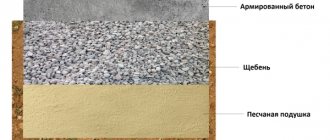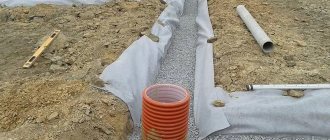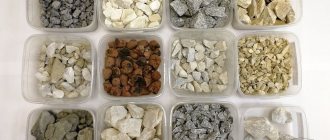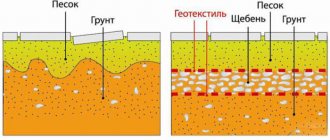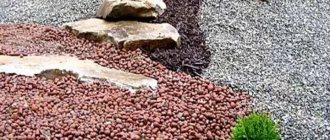Technical properties of crushed stone
Depending on the type, crushed stone has certain technical characteristics. When choosing the type of crushed stone, it is necessary to take into account not only its fractionation, but also its characteristics. Different construction works require different types of crushed stone, and the quality of the entire work can depend on the correct choice of fraction.
In accordance with GOST, the following main characteristics of crushed stone are distinguished:
- Frost resistance. This property shows the ability of crushed stone to withstand alternate freezing and thawing in a wet state while maintaining its properties and structure. According to frost resistance, types of crushed stone are: highly resistant (F200,300,400), resistant (F50,100,150) and unstable (F15,25).
- Strength characterizes the ability of crushed stone to withstand loads of a certain magnitude. By strength, crushed stone is distinguished: super-strong (M1400-M1600), high-strength (M1200-1400), strong (M800-M1200), medium strength (M600-M800), weak strength (M300-M600), very weak strength (M200).
- Flakiness. This is the main and very important property of crushed stone, showing the presence of relatively smooth edges (sides) on the “grains” in the total mass of crushed stone. According to the flakiness, crushed stone is: cuboid - group 1, improved - group 2, normal - group 3. The most effective is crushed stone of the 1st flakiness group. It is easy to tamper and more durable. Cuboid crushed stone is an excellent material for creating foundations and road surfaces.
What is the difference between crushed stone
Crushed stone and gravel are small rocks. The diameters of their particles can be as small as 5 mm and reach up to 200 mm.
You can read about what crushed granite stone GOST 8267 93 is from this article.
The photo shows the difference between crushed stone and gravel:
Differences in production processes
The gravel has a round shape with fuzzy edges. Found in nature in the form of rock particles. It is formed as a result of temporary rock splitting. It is industrially collected from the stone surface using special equipment. Then the gravel undergoes calibration and screening, and, if necessary, washing. As a result, the material obtained after all operations is gravel.
The GOST crushed stone fraction and other characteristics can be read in the article.
The video explains the difference between crushed stone and gravel:
Since it is obtained as a result of the natural and prolonged destruction of rocks, it has not only a smooth surface, but also many foreign inclusions, such as clay, sand, particles of organic substances and others. This leads to the fact that the material must be sorted into fractions, sifted, and in some cases washed, which makes the production process more labor-intensive. But as a result of this, the building material gets rid of impurities.
The difference between gravel and crushed stone can be found in the article.
It consists of various rocks and minerals, so when assessing its strength, the weakest grains from several batches are selected. There are several types of gravel, depending on where the material is mined. There are: sea, river and mountain. It is the mountain subspecies that has found application in construction.
Crushed stone is also the result of crushing rocks, but to obtain it, they do not wait for their natural destruction, but use special equipment. It can be a by-product during mining and processing operations. Several types of technology are used for its production. Depending on the size of the material required, the type of crushing machines is selected. If it is mined in a quarry, then stationary equipment is used, and if in hard-to-reach places, then mobile models are used.
The weight of crushed stone of fraction 20-40 per 1m3 and other characteristics of the building material can be found in the article.
When purposefully extracting crushed stone, a rock explosion is first carried out; for this, a hole is cut in the mountain rocks into which explosives are placed. After the explosion, experts check the size of the rock fragments, and if the stone is large, it is undermined again.
After this, using special machines, the resulting fragments are delivered to crushing and screening machines (mills and screens), and they crush the rock to the required size.
In the case of mining and processing operations, crushed stone is obtained as a by-product. The resulting rocks are sifted, and after that the “empty” fraction, which does not contain the necessary substances, is selected. Most often, blasting is used to produce crushed stone, so its extraction is more labor-intensive than gravel.
For those who want to know how much sand, crushed stone, cement is in a cube of concrete, you can find out from the article.
What does gravel look like?
Externally, you cannot confuse these materials and how they look. Let's start with the fact that crushed stone is presented in one gray color, while gravel has different colors, so it is more often used for decoration. Unlike crushed stone, it has clear shapes formed by nature.
Depending on the location of extraction, gravel is divided into the following types:
- mountain;
- granite;
- nautical;
- river.
The article describes the fraction of crushed stone 40 70 and other characteristics of the building material.
Streamlined shapes due to contact with water have a river and marine appearance, so it is more often used for decorative purposes, since its rounded edges do not adhere well to other substances. For concrete work, glacial (granite) and mountain crushed stone is used. The latter varieties can be confused with each other.
Gravel is divided into three subgroups depending on the parameters of its particles:
- small stones, the size of which reaches from 1 mm to 1.25;
- medium, reaching 5 mm;
- large particles over 10 mm.
Compared to gravel, crushed stone has a more angular and rough shape, thanks to which it is more in demand in construction. It has excellent adhesion to other materials and is a good filler for construction voids.
For those who want to know what the volumetric weight of crushed stone is, it is worth reading this article.
Dimensions are related to the scope of its application:
- minimum fractions of up to 5 mm are used for roads; they are used to sprinkle paths against ice;
- over 5 and up to 10 mm are used in concrete work and the production of building slabs;
- stones up to 20 mm are used in the construction of bridges and serve as the basis for asphalt roads, and are also used when pouring foundations for buildings;
- fractions over 20 mm, but less than 40 are used for the construction of complex structures;
- up to 70 mm – participate in the construction of multi-storey buildings;
- over 70 and up to 120 mm are used for decorative purposes.
You can find out the differences between crushed stone and gravel here in the article.
Crushed stone has high strength and resistance to low temperatures. According to the degree of frost resistance, it has several groups. As you can see, crushed stone is more varied in size than gravel.
Interaction with other materials
Considering the fact that gravel has more rounded shapes, it is significantly inferior in adhesion characteristics to other building materials compared to crushed stone. The presence of corners and a rough plane in the latter contributes to better bonding with concrete and optimal compaction. It is capable of filling any construction voids. For example, when constructing a rubble foundation, they, together with cement, fill the internal part, made of large stones that do not fit tightly together.
Areas of application
The characteristics of crushed stone have found application in construction work during the construction of reinforced concrete structures and concrete objects. Its finest fraction is used for sprinkling paths during icy conditions, as well as for leveling sports fields.
For those who are interested in knowing what heavy concrete consists of, you can read this article.
Due to its decorative form, gravel is used more often in landscape design:
- when decorating garden paths and flower beds;
- for decorating building facades;
- they make models of ponds;
- it is filled in on the site of roads and various recreation areas.
Gravel is also used in construction as a “cushion” in the foundation. It is also useful to read about the use of pebbles in landscape design.
Types of crushed stone by origin
Depending on what rock the material was made from, the following types of building crushed stone are distinguished:
- granite;
- gravel;
- limestone (dolomite);
- slag;
- slate;
- secondary.
Granite crushed stone is produced on the basis of granite rock mass. As a rule, this type of crushed stone has a reddish color and uneven edges. However, this only improves the ability to adhere to the cement mortar in the concrete mixture, which ensures good strength characteristics.
Currently, several types of granite crushed stone are produced depending on the fraction. The “grinding” size of crushed granite can vary from 0-5 mm to 70-120 mm. Granite crushed stone is a widely popular building material due to its excellent technical characteristics. Depending on the fractional composition, granite crushed stone is used in various fields.
Crushed gravel is obtained by sifting quarry rocks, or by explosive method in the development of rocks. Crushed stone is a grayish mass of various fractional compositions. To produce crushed stone, they are guided by GOST 8267-93, which specifies the required technical characteristics of the material and production technology. Compared to granite, crushed gravel has less strength, which determines the scope of its application.
The highest strength grade of crushed gravel is only M 1200. Although crushed gravel is inferior to granite in such characteristics as strength and appearance, it has a fairly large number of advantages. The process of extracting crushed gravel is much easier than granite and requires less effort and money. The fact is that rocks are less durable compared to granite, which means that their development will require less powerful equipment and machines. In addition, gravel is considered a very common material, which also leads to a relatively low cost of the material.
The prevalence of “deposits” of crushed gravel contributes to great competition in the extraction of this material, which also reduces its market value. Crushed gravel has a lower radioactive background than granite. Crushed gravel is produced in four fractions: 3-10 mm, 5-20 mm, 5-40 mm, 20-40 mm.
Limestone (dolomite) crushed stone , as a rule, is used in construction in lightly loaded structures. It can be used for the production of piece products from reinforced concrete, provided that no heavy load is placed on these parts. Crushed limestone is a product of crushing sedimentary rocks, consisting mainly of calcium carbonate. Limestone crushed stone is mined in quarries. The material is quite widespread, so crushed limestone is quite inexpensive.
Limestone crushed stone has low strength, so its scope of application is much narrower than that of granite or gravel. Crushed stone is widely used in road construction when laying roads with low loads. Limestone crushed stone is also widely used in the production of lime, soda and mineral fertilizers. Lime crushed stone is produced in three types of fractions, which determine the scope of their application. Crushed limestone is produced in fractions of 5-20 mm, 20-40 mm and 40-70 mm.
Slag crushed stone is an affordable building material obtained from waste from the metallurgical and chemical industries, as well as from the combustion of solid fuels. Slag crushed stone has a high density. Its density is higher than that of granite crushed stone. However, high density characterizes a large mass of material, which is a rather significant drawback in construction. Slag crushed stone has a higher water absorption coefficient compared to granite. Therefore, structures built with such crushed stone should not often come into contact with moisture.
Slag crushed stone should also not be subjected to frequent freezing, because the frost resistance characteristics of this material are very small (only 15 cycles versus 300 cycles of granite crushed stone). The use of crushed slag stone is advisable if all its shortcomings are fully taken into account. In general, depending on the fraction (0-5, 5-20, 20-40, 40-70, 70-120 mm), slag crushed stone is often used in civil and road construction, as well as in the production of building materials.
Crushed shale is a material obtained from rocks of volcanic origin. Externally, crushed shale will look like a mound of oblong, flat stone. The color of crushed slate can be burgundy, yellow, brown, grey, anthracite or green. Shales are widely used in construction and materials production. For example, there is a type of shale, when split, many thin plates are formed. Such slates are used for roofing materials.
The product of shale crushing, crushed stone, is also widely used in construction. Crushed shale is used for the construction of roads and monolithic reinforced concrete structures, as well as for landscape decoration. Depending on the faction, crushed slate stones are used to decorate the decorative elements of the surrounding area and create interesting paths. However, it should be taken into account that before choosing a specific fraction and type of shale crushed stone, it is necessary to study its characteristics in detail.
Currently, so-called secondary crushed stone is quite common. It is obtained by crushing construction waste. Secondary crushed stone is produced by crushing monolithic structures, having previously removed the reinforcing frame and metal embedded parts from them during the primary split.
Recycled crushed stone, due to its relatively low cost, has a very cheap price. So, for example, when compared with granite, recycled crushed stone from construction waste will cost about half as much. The cost of concrete produced from recycled crushed stone will be reduced by up to 30% compared to mixtures made with granite aggregate. However, such low cost of the material also indicates its reduced strength and frost resistance. The maximum grades for strength and frost resistance of secondary crushed stone are M800 and F150, respectively. However, even with such indicators, recycled crushed stone can be used in various fields.
On the stroyka.ru portal you can study information on types of crushed stone with color photos of the materials presented, as well as find out where to buy crushed stone at the lowest price.
Gravel and crushed stone - differences
Construction work involves the use of crushed stone and gravel. These fine minerals are very similar to each other. Both are formed from rocks and are used for almost similar construction work. But still, upon closer examination of these two building materials, significant differences can be identified. This becomes noticeable not only visually, but also practically. Each of them has its own application features. They also interact differently with other materials. During construction, such indicators are very important.
Differences in properties and characteristics
Crushed stone and gravel are small rocks. The diameters of their particles can be as small as 5 mm and reach up to 200 mm.
You can read about what crushed granite stone GOST 8267 93 is from this article.
The photo shows the difference between crushed stone and gravel:
Differences in production processes
The gravel has a round shape with fuzzy edges. Found in nature in the form of rock particles. It is formed as a result of temporary rock splitting. It is industrially collected from the stone surface using special equipment. Then the gravel undergoes calibration and screening, and, if necessary, washing. As a result, the material obtained after all operations is gravel.
The GOST crushed stone fraction and other characteristics can be read in the article.
The video explains the difference between crushed stone and gravel:
Since it is obtained as a result of the natural and prolonged destruction of rocks, it has not only a smooth surface, but also many foreign inclusions, such as clay, sand, particles of organic substances and others. This leads to the fact that the material must be sorted into fractions, sifted, and in some cases washed, which makes the production process more labor-intensive. But as a result of this, the building material gets rid of impurities.
The difference between gravel and crushed stone can be found in the article.
It consists of various rocks and minerals, so when assessing its strength, the weakest grains from several batches are selected. There are several types of gravel, depending on where the material is mined. There are: sea, river and mountain. It is the mountain subspecies that has found application in construction.
Crushed stone is also the result of crushing rocks, but to obtain it, they do not wait for their natural destruction, but use special equipment. It can be a by-product during mining and processing operations. Several types of technology are used for its production. Depending on the size of the material required, the type of crushing machines is selected. If it is mined in a quarry, then stationary equipment is used, and if in hard-to-reach places, then mobile models are used.
The weight of crushed stone of fraction 20-40 per 1m3 and other characteristics of the building material can be found in the article.
When purposefully extracting crushed stone, a rock explosion is first carried out; for this, a hole is cut in the mountain rocks into which explosives are placed. After the explosion, experts check the size of the rock fragments, and if the stone is large, it is undermined again.
After this, using special machines, the resulting fragments are delivered to crushing and screening machines (mills and screens), and they crush the rock to the required size.
In the case of mining and processing operations, crushed stone is obtained as a by-product. The resulting rocks are sifted, and after that the “empty” fraction, which does not contain the necessary substances, is selected. Most often, blasting is used to produce crushed stone, so its extraction is more labor-intensive than gravel.
For those who want to know how much sand, crushed stone, cement is in a cube of concrete, you can find out from the article.
External character
Externally, these materials cannot be confused. Let's start with the fact that crushed stone is presented in one gray color, while gravel has different colors, so it is more often used for decoration. Unlike crushed stone, it has clear shapes formed by nature.
Depending on the location of extraction, gravel is divided into the following types:
- mountain;
- granite;
- nautical;
- river.
The article describes the fraction of crushed stone 40 70 and other characteristics of the building material.
Streamlined shapes due to contact with water have a river and marine appearance, so it is more often used for decorative purposes, since its rounded edges do not adhere well to other substances. For concrete work, glacial (granite) and mountain crushed stone is used. The latter varieties can be confused with each other.
Gravel is divided into three subgroups depending on the parameters of its particles:
- small stones, the size of which reaches from 1 mm to 1.25;
- medium, reaching 5 mm;
- large particles over 10 mm.
Compared to gravel, crushed stone has a more angular and rough shape, thanks to which it is more in demand in construction. It has excellent adhesion to other materials and is a good filler for construction voids.
For those who want to know what the volumetric weight of crushed stone is, it is worth reading this article.
Dimensions are related to the scope of its application:
- minimum fractions of up to 5 mm are used for roads; they are used to sprinkle paths against ice;
- over 5 and up to 10 mm are used in concrete work and the production of building slabs;
- stones up to 20 mm are used in the construction of bridges and serve as the basis for asphalt roads, and are also used when pouring foundations for buildings;
- fractions over 20 mm, but less than 40 are used for the construction of complex structures;
- up to 70 mm – participate in the construction of multi-storey buildings;
- over 70 and up to 120 mm are used for decorative purposes.
You can find out the differences between crushed stone and gravel here in the article.
Crushed stone has high strength and resistance to low temperatures. According to the degree of frost resistance, it has several groups. As you can see, crushed stone is more varied in size than gravel.
Interaction with other materials
Considering the fact that gravel has more rounded shapes, it is significantly inferior in adhesion characteristics to other building materials compared to crushed stone. The presence of corners and a rough plane in the latter contributes to better bonding with concrete and optimal compaction. It is capable of filling any construction voids. For example, when constructing a rubble foundation, they, together with cement, fill the internal part, made of large stones that do not fit tightly together.
Areas of application
The characteristics of crushed stone have found application in construction work during the construction of reinforced concrete structures and concrete objects. Its finest fraction is used for sprinkling paths during icy conditions, as well as for leveling sports fields.
For those who are interested in knowing what heavy concrete consists of, you can read this article.
Due to its decorative form, gravel is used more often in landscape design:
- when decorating garden paths and flower beds;
- for decorating building facades;
- they make models of ponds;
- it is filled in on the site of roads and various recreation areas.
Gravel is also used in construction as a “cushion” in the foundation. It is also useful to read about the use of pebbles in landscape design.
Differences in price
Depending on the rocks from which crushed stone is produced, there are several varieties, each of which has its own price. It is worth noting that large fractions are somewhat cheaper than fine fractions. The final cost will be influenced by the volume of material purchased. We will indicate average prices in order to draw a comparative parallel between gravel and crushed stone.
Cost of crushed stone per 1 m3:
- limestone type from 1500 rubles;
- granite from 2100 rubles;
- gravel from 1780 rubles;
- secondary – 1150 rubles.
What is the specific gravity of concrete can be found in this article.
The price of gravel per 1 m3 is approximately 1,700 rubles.
As you can see, the cost of materials is approximately the same, although the costs of their production are different.
To summarize, let us highlight the main differences between crushed stone and gravel:
- the first material is formed as a result of mechanical intervention, or rather, an explosion, and the second is obtained as a result of the natural destruction of natural rocks;
- Crushed stone has a wider dimensional grid and is used for construction work, while gravel plays a more decorative role, although it is sometimes used in the construction of foundations. This is due to the shape of the material; crushed stone is angular and adheres better to concrete and other building materials, while gravel is smooth;
- the main positive feature of crushed stone is its good adhesion and physical properties, while gravel has a decorative appearance.
Types of gravel and granite crushed stone by fractional composition
When talking about what types of crushed stone there are, we should not forget about its fractional division. Depending on the source raw material, this or that crushed stone is produced in several types of fractions. Granite and crushed gravel are the most common in construction.
Crushed gravel of a fraction of 3-10 mm is used for screening, 5-20 mm is used in the production of small-sized construction products (paving slabs, etc.), 20-40 mm - for larger monolithic products (for example, rings for a well) . Crushed gravel of 20-40 mm fraction is widely used for the production of various concrete and reinforced concrete structures.
Granite crushed stone has a more diverse fractionation. Depending on the type of granite crushed stone fraction, its application also depends. For example, a fraction of granite crushed stone of 5-20 mm is considered small and is widely used for monolithic construction.
Crushed stone of medium fraction 20-40 mm is also excellent for concrete and the production of reinforced concrete structures. The coarse fraction of 20-40 and 40-70 mm is appropriate when it is necessary to produce large volumes of concrete, as well as for pouring large, massive structures. Such crushed stone is suitable for the construction of industrial facilities and highways. Fractions of granite crushed stone 70-120, 120-150, 150-300 can also be called rubble. Such crushed stone is usually used for more decorative purposes. For example, for the construction of stone fences and hedges. The smallest fraction of granite crushed stone 0-5, 0-20, 0-40 mm is widely used in road construction.
Crushed stone
To obtain crushed stone, you need a source material - usually rock. They are blasted in industrial quarries, followed by the process of crushing using special equipment. Then, all crushed mass goes through a sorting process according to grain size. For this purpose, special industrial sieves with holes of different diameters are used. Thus, crushed stone is divided into fractions. Different fractions of crushed stone have one common use - filler in concrete mortar to create a frame, the basis of a future structure. In other cases, there are some differences in application.
Let us list the main fractions of crushed stone:
- 5-10 mm;
- 5-20 mm;
- 10-20 mm;
- 20-40 mm;
- 40-70 mm.
The first, finest fraction is successfully used in the production of asphalt. The second and subsequent ones are in demand for the production of ready-mixed concrete for pouring the foundations of various buildings and objects. Fraction 5-20 is also used in the manufacture of curbs, paving slabs, concrete products, and drainage systems. Crushed stone of larger fractions is used in the construction of roads, airfield pavements, and railway embankments. For landscape work - crushed stone, which is rarely used due to its higher cost.
Types of crushed stone
Granite crushed stone - according to technical indicators, this type shows the highest results in strength, frost resistance and durability. Its price is also the highest, since maximum energy resources are spent for its production. The starting material is granite rocks, which is widely used and in demand. This type of crushed stone is used in places where special strength is required, where high loads are expected on the object being built. It has an acceptable radioactive background, but because of this, it is not indicated for use in the construction of housing for people, especially children's facilities and hospitals. Crushed gravel is mined by quarrying or raised along with sand from the bottom of rivers and lakes. After cleaning, it undergoes a process of crushing and sorting into fractions, after which it is ready for sale. In terms of technical indicators, it is somewhat inferior to its predecessor and has a lower cost. The main advantage of crushed gravel is the absence of a radioactive background. Thanks to this, it is widely used in the construction of housing, children's facilities, hospitals, landscape work... Crushed limestone is a popular type among the population due to its low price. It has the lowest technical performance, but is quite suitable material for a number of works in the private sector. In terms of its chemical composition, it is calcium carbonate, which is susceptible to dissolution in an aqueous environment. Therefore, it is not recommended for foundation construction; over time, a humid environment will destroy this crushed stone.
The main direction in construction work is objects with low future load on the object. Secondary roads, backfilling, decoration of various objects, park recreation areas. Since these types of crushed stone are crushed and sorted by grain size, screenings are obtained as associated material - a cheap material that also has its own places of application. All types of crushed stone have a rough surface, due to which it has good adhesion in the concrete solution and does not immediately settle to the bottom. The working solution has a uniform density and mass. The most valuable crushed stone grain shape is cuboid. It is this form that has the highest bulk density and makes it possible to obtain an extremely strong and reliable foundation or foundation for a structure, especially if the granite option is used.
Scope of application of crushed stone
Types of crushed stone are very diverse. However, the use of crushed stone in construction is extremely widespread and in demand. Currently, the use of crushed stone in the construction of buildings, structures and roads affects almost all stages of construction. Thanks to high-quality crushed stone, strong, durable structures are obtained that ensure the safety of erected buildings and structures.
However, crushed stone is also widely used in such applied areas as landscape design. Small fractions can be safely used for filling in flower beds, creating alpine slides, and large fractions can be used for laying paths or stone fences.
You can buy crushed stone at an attractive price in your region with delivery to the site on the construction portal stroyka.ru. With us you will find reliable suppliers of building materials of all types and purposes in your region. And if you are in doubt about the choice, then the construction portal stroyka.ru will help you understand the variety of crushed stone, as well as select the necessary materials at a low price.
